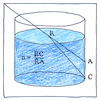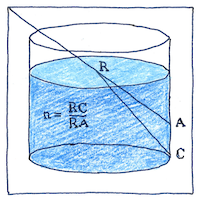Ibn Sahl,
Thomas Harriot,
Willebrord Snellius,
René Descartes
optics

|
Snell’s law
In a glass of water, light bends at the surface, or at a greater angle, light reflects. In 984, Ibn Sahl taught that the ratio of lengths of the refracted path and the straight path is constant for all angles of incidence; therefore, lenses should have hyperboloidal surfaces. In 1602, Thomas Harriot rediscovered Sahl’s law, but he didn’t publish his work. In 1621, Willebrord Snellius also rediscovered it, and Huygens published his work postumously. By 1637, René Descartes rediscovered it again, and used the law to design microscopes and telescopes.
Snell’s window
Underwater, divers look up into a cone of light to view the hemispherical world above through a circle on the surface of the water.
Law of refraction
If reflection is both mirroring an image and meditating upon it, then refraction should be both bending the path of light and deflection in the eye. Images on the retina are upside down. Parallel lines seem to merge at infinity. There seems to be no blind spot where the nerve penetrates the optic disk.



By Descartes’ time, rediscovering Snell’s law had became somewhat routine, with each discoverer finding his own means of deriving the same result, but the fundamental physics was still uncertain. Descartes assumed that the speed of light is infinite and his derivation of the law used the conservation of momentum. In 1662, Pierre de Fermat assumed that the speed of light is finite, rejected Descartes’ work, and derived the law using the principle of least time.
See also in The book of science:
Readings in wikipedia:
Other readings: